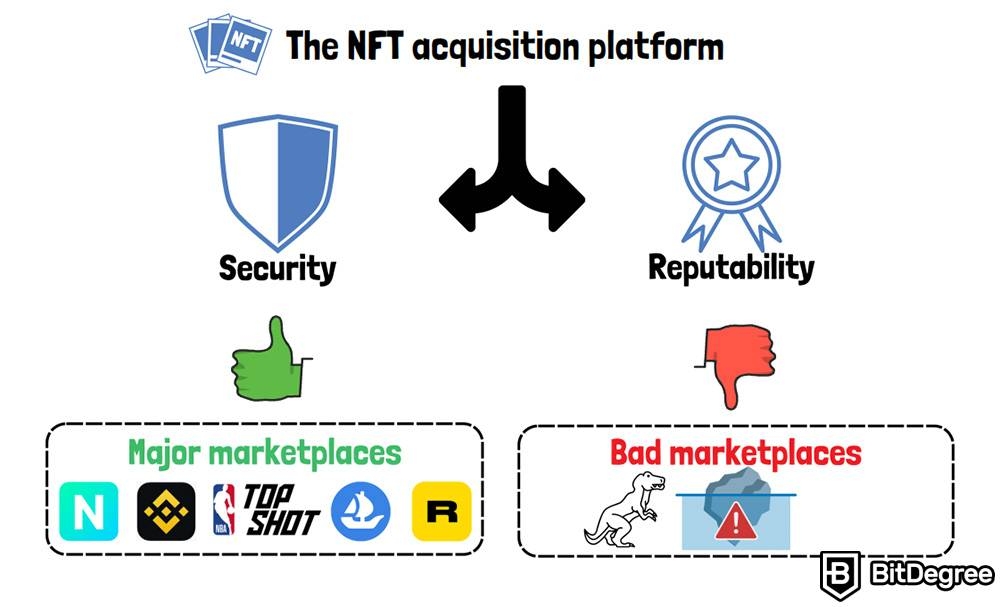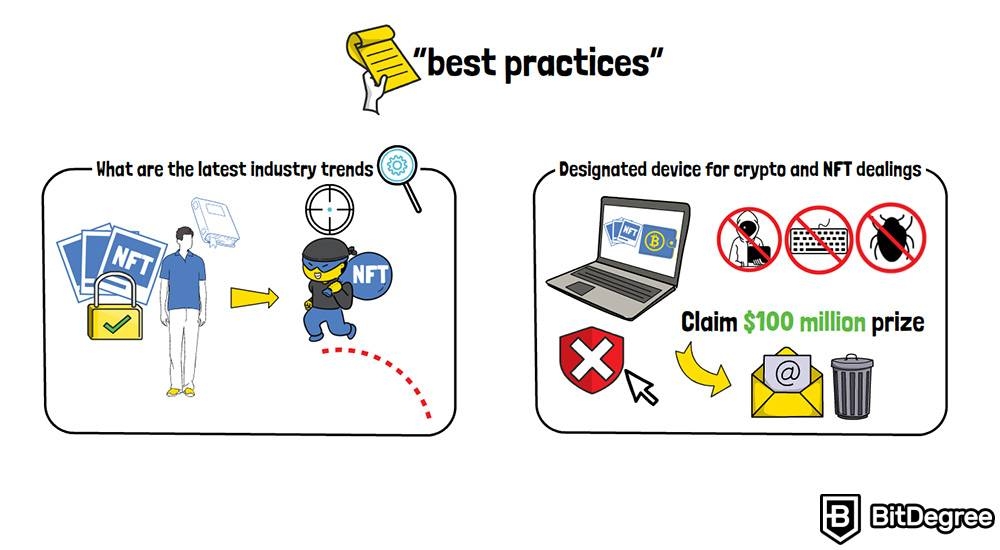5.4 How to Store NFTs: Best Practices
Stop overpaying - start transferring money with Ogvio. Sign up, invite friends & grab Rewards now! 🎁
In this section, I’m going to tell you everything that you need to know about how to store NFTs!
As the non-fungible token market sees increasing popularity and a growing number of use cases, so do the risks associated with NFT theft expand, as well. There are some real horror stories about people losing incredibly valuable NFTs to scammers and hackers, alike!
All of those stories have something in common, however - some sort of an oversight that allowed the said scammers to access the NFT holders’ wallets, and steal their tokens. This is why it’s crucial to learn about the best NFT storing safety practices, as soon as possible!
In this section, we’re going to talk about NFT storage. Specifically, I will tell you about the most notable NFT safekeeping practices, and the best places where to store NFTs, as well. In addition to that, I will also give you a few tips on how to avoid putting your NFTs in jeopardy, in general.
Let’s get to it!

Video Explainer
Video Explainer: How to Store NFTs: Best Practices
Reading is not your thing? Watch the "How to Store NFTs: Best Practices" video explainer
How to Store NFTs in 2023 (3 Most Secure Ways Explained)


First Things First - Before You Acquire Your NFTs
To start things off, we need to very quickly talk about the process of acquiring your first NFTs. Now, I won’t go into detail about what this entails - if you’d like to learn about NFT trading, I highly recommend checking out a section dedicated to this topic.
Instead, for now, I just want to run through a few safety tips that you should utilize, when you’re just starting out within the industry. While it’s not yet directly related to the question of how to store NFTs, you will eventually see how it all ties in.

So, whenever you want to start acquiring non-fungible tokens, there are essentially three points that you need to consider, and look into:
- The safety level of the device that you’re using;
- The platform which you will use to buy your first NFTs;
- The safety of the NFTs themselves.
When it comes to your device, it’s essentially just your common, everyday digital safety practices - make sure that your computer or mobile phone is virus-free, that there are no keyloggers or other similar malware hiding within it, and that it doesn’t have its security compromised, in general. If any of these points aren’t met, you might not be able to HODL NFTs for long.
Think of it this way - imagine that you’ve bought a brand new car, and have left it in your driveway, with your wallet on the front seat. Now, that’s not ideal, in and of itself, but on top of that, you left the car unlocked, eliminating the last potential security measure. A thief could come up to the car, open the door, and just take the wallet!
The same is true with your device, too - if you use even the best crypto wallet for NFTs on a faulty and virus-ridden computer, chances are that all of the security that this wallet provides will become trivial. Your newly-acquired NFTs could be stolen even before you transfer them to the wallet in question.

Next up, the NFT acquisition platform. Once again, it all boils down to security and reputability - while it’s not something that you’d need to worry about when buying NFTs from major marketplaces (if you’re looking for the best NFT wallet for OpenSea or Rarible, you probably know what I’m talking about), if you’re utilizing the services of some shady market, this can lead to you losing not only your NFTs, but also all other tokens in your wallet, as well!
Such malicious platforms are rare, I’ll admit, but you still need to remain vigilant - what I would essentially do is stick with the time-tested platforms, like the ones I’ve just mentioned earlier.
Lastly, the safety of NFTs themselves. This is a bit of an odd point, but with NFT technology developing at a rapid rate, this could become a major issue, as well. Specifically, certain NFTs might possess some sort of malware themselves - this would, once again, cause a lot of danger to the contents of your crypto wallet.
Note that I’m not necessarily talking about the NFT, as in, the token itself - it might just be a Trojan horse! Instead, the malicious code or program could be hidden within some sort of a “bonus” that’s given out to the buyers of the NFT. Just something to keep in mind and consider!
With that being said, you should now have a better idea of what to pay attention to when you’re buying your first NFTs. Now, then - let’s move on to the actual “how to store NFTs” question at hand.
The Three NFT Storage Options
Essentially, when it comes to storing NFTs safely, there are three main methods that you should know about - software wallets, hardware wallets, and something called IPFS.
I will continue with the assumption that you already know and understand the basics of what is a cryptocurrency wallet, and how these platforms work. If that’s not the case, make sure to check out other sections in this Crypto 101 Handbook - there are sections dedicated to exploring just that! In regards to IPFS, though, we’ll cross that bridge when we get there - that’s a bit of a more complex topic.
Software Wallets

So, starting off, you have software wallets. A significant number of cryptocurrency wallets these days allow their users to store both “traditional” crypto coins & tokens, as well as NFTs on them. Think about, say, MetaMask - you can store your ETH coins on it, as well as all other ETH-related tokens, but the wallet now supports different blockchain-based non-fungible tokens, as well! This is why, at one point, it was commonly referred to as the best Ethereum wallet for NFTs.
In a very general sense, software wallets aren’t the ideal choice, for anyone looking for top-tier NFT storage security. This is because these wallets maintain a constant connection to the internet. In turn, it renders them a target for many wannabe hackers and crypto thieves. Thus, whether it be a Solana NFT wallet, or any other similar NFT storage solution, software wallets do face this issue.
That being said, this shouldn’t be over-exaggerated, either. If you’re careful in how you store your NFTs, and don’t publicize your holdings for the entire world to see, chances are that software wallets can be perfectly safe, as well. On top of that, they are very convenient - you can access your NFTs really fast, and perform trades without too much hassle.
Hardware Wallets

In contrary to that, you have hardware storage, as the best NFT wallet option. These are special devices that allow you to store your cryptocurrencies and NFTs on them - some hardware wallets store NFTs directly, while others might need you to connect them to some software wallet. That’s going into very circumstantial specifics, though - I won’t bore you with such details.
As I’ve eluded to earlier, however, hardware wallets are generally considered to be very safe, but at the same time, they tend to be a bit more of a nuisance to use, on a daily basis.
It’s like, software wallets are your credit or debit card, and hardware wallets are cash. When you’re at the store, you could just swipe your card and pay for groceries that way, or count your coins and banknotes, come up with the correct amount, and pay in cash. The former method is a bit faster and essentially hassle-free, but it doesn’t really make all that big of a difference, at the end of the day.
When it comes to hardware wallets, a question that you might come across pretty often is this - can you store NFTs on Ledger? This is one of the most popular hardware crypto storage brands on the market, so it’s really not too odd that a question like this comes up.
Let me tell you right now - yes, you can store NFTs on Ledger. As you might imagine, however, this is a whole, separate topic.
InterPlanetary File System (IPFS)

Moving on, your last option for how to store NFTs is an IPFS, or an “InterPlanetary File System”. Yes, I know - the name is very eccentric.
IPFS is actually quite a complex concept. However, the simplest way of how it can be explained is that it’s a data-storing solution that’s not too different from a blockchain. So, if you store your NFTs on IPFS, they will essentially be based on a network of computers, without a single, central node.
Many NFT-related platforms support IPFS storage, for the underlying file of the non-fungible token. For example, if you create an NFT that’s an image of your dog, on the OpenSea marketplace, you could store that image on an IPFS - the actual token, however, will be based on a blockchain network (such as Ethereum, Binance Chain and so on).
Once again, IPFS is pretty complicated to wrap your head around. It’s also an NFT storage solution that most people will end up avoiding - instead, the majority of NFT fans will likely turn to software or hardware wallets.
That’s certainly not a bad idea! With wallets such as MetaMask or Ledger, you can expect a lot of user-friendliness and feature variety. On top of that, such established NFT wallets will come equipped with state-of-the-art security measures, as well!
General NFT Storage Tips
Moving on, the last bit of advice that I’d like to give you has to do with some general “best practices” when it comes to how and where to store NFTs. I’ve already touched on a few of the bigger points previously - ensuring that your device is virus-free, using established NFT marketplaces, and so on.

However, the aforementioned “best practices” would include frequent check-ups on what are the latest industry trends, as well. Scammers and crypto thieves try to stay ahead of the curve, and utilize the latest tactics of stealing people’s NFTs - it’s your job to protect your assets! This can be done much easier if you already know what to expect, and what the latest scams are like.
Naturally, if possible, it would be a good idea to have a fresh, designated device, for all of your crypto and NFT dealings. This would frankly eliminate the possibility of your system being compromised! That is, if you don’t click on any shady links online, and don’t decide to claim that $100 million prize that you’ve now won three times, and that’s waiting for you in your email’s spam folder.
All in all, make sure to choose the NFT storage solution that seems to work best for you, and perform regular check-ups on how your NFTs are doing within the wallet of your choice.
Final Thoughts
Even though we’ve talked quite a bit about how to store NFTs, this topic, in itself, is rather expansive. We could go on about the best Ethereum wallet for NFTs, as well as Solana NFT wallet options, or even address questions of how to stake NFTs, too. These are all huge talking points, however, and thus, they deserve separate sections, altogether.










